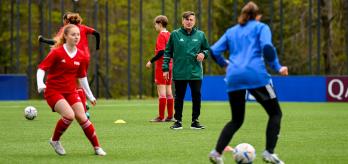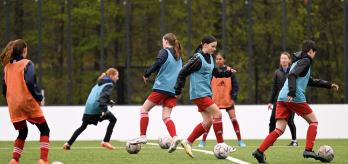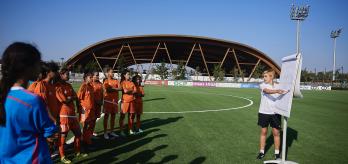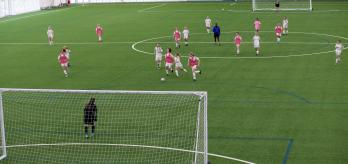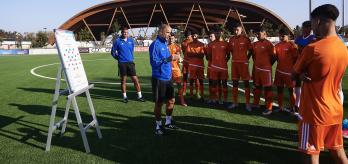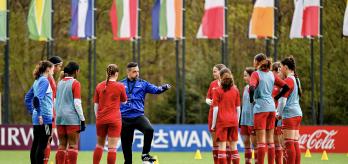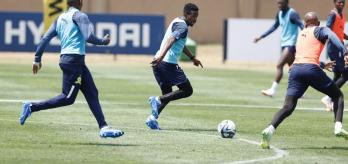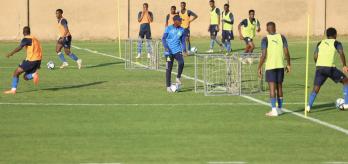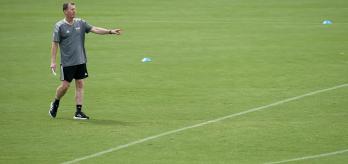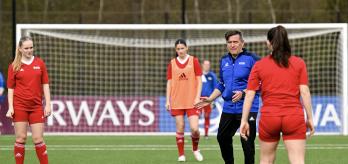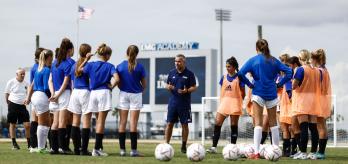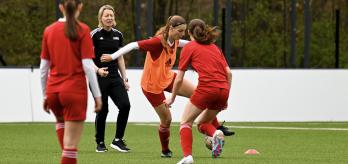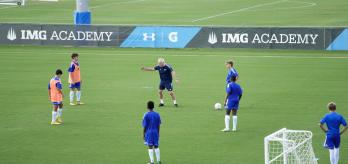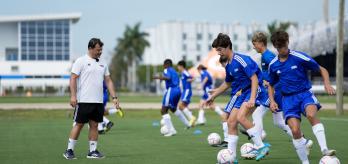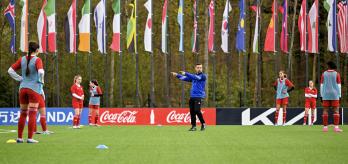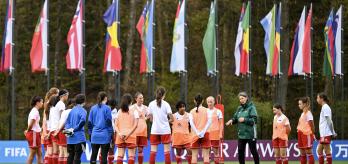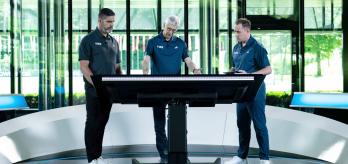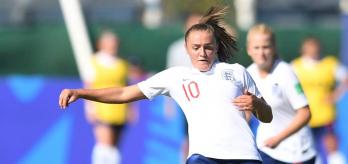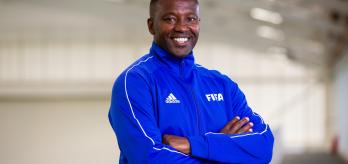In what follows FIFA Technical Expert Sean Douglas conducts a session honing precisely this skill. As a player, Douglas represented New Zealand at the international level and played a majority of his club football in the Australia’s National Soccer League, the country’s top-tier preceding today’s A-League.
In this football training method, players engage in the "whole-part-whole" approach. A method of learning a skill in which the learner tries to perform the whole skill from time to time after practising parts of the skill. This method ensures a comprehensive understanding and effective application of the technique in game scenarios. To start, the group play a 7v7 game which initially is free-flowing but eventually evolves into a zonal possession exercise. Next, players partake in a passing exercise that practices the specific abilities required to flourish in the first exercise. After getting a taste for the necessary movement and technical skills required in these specific situations, the group are brought back to the original 7v7 game to apply their learnings.
Session overview
Key coaching points:
-
Adopt a mindset that strives to contantly play forward passes.
-
Take up positions on the field which create the angles necessary to play a forward pass after recieving the ball.
-
Conduct movements in relation to one or two other team-mates in a way that creates space to encourages the forward pass.
Part 1: 7v7 small-sided game (whole)
The session begins by focusing on “the whole”, with players contesting a small-sided 7v7 game. Players are given the freedom to play with no constraints, which allows them to encounter the issues that may arise during open play. The coach observes the challenges that players may face and focuses particularly on the session objectives.
-
Mark out a 50 x 25m exercise area.
-
Place a full-size goal at each end of the exercise area.
-
Position a goalkeeper in each of the goals.
-
Set both teams up in a 2-3-1 formation.
-
Play an unrestricted 7v7 game.
-
If the ball goes out of play, play restarts with the opposing team’s goalkeeper.
-
Split the exercise area into thirds using cones.
-
Limit players to zones: arrange a 2v1 in the defensive zone, a 3v3 in the central zone and a 1v2 in the attacking zone.
-
Players cannot leave their zone unless they progress the ball from one zone to another.
-
Only players who progress the ball can move into the next zone.
-
If possession is lost, players must quickly return to their zones.
-
Frame the session by linking the practice to the game with the use of a tactical board, if necessary.
-
Show players the structure they need to work in, as it helps them to visualise their role on the pitch.
-
Create an awareness of the issues players face by asking them questions both during and at the end of the exercise.
-
Condition the game to help players to identify solutions, such as the timing of runs or positional play.
-
Intervene to adjust positioning if players struggle to progress the ball.
-
Ask players where and why they should take up certain positions.
-
Stop the play when players make clear mistakes in possession. For example, in the case of the defensive players, if they try to play through pressing players, suggest that they play the ball back to the goalkeeper or play a cross-field pass to their defensive team-mate.
Part 2: Passing exercise (part)
The purpose of this drill is to allow players to focus on some of the fundamental aspects of play that will allow them to perform the main exercise more effectively. Douglas introduces a pass-and-move drill that aims to help players to gain a greater awareness of what they must do to progress the ball more effectively.
-
Use the centre circle of the pitch as the exercise area.
-
Split the group into two teams of 7 (oranges and blues).
-
Position four cones (two orange and two blue) around the edge of the centre circle so that the two coloured cones face each other, forming a cross shape.
-
Place 3 players from each team inside the centre circle.
-
Position 2 orange players either side of one of the orange cones, and place the other 2 orange players either side of the orange cone facing it.
-
Place the blue players in the same positions (as the orange-team players) at the two blue cones.
-
Give each team a ball.
-
The exercise starts with a blue and an orange player positioned at a cone in possession.
-
They pass the ball to a team-mate inside the centre circle.
-
The receiving player takes a touch to control before dribbling the ball and playing it to a team-mate positioned at the cone on the other side of the centre circle.
-
Players follow their passes and take the place of the recipient of their pass.
-
Use one ball.
-
The two teams compete for possession.
-
The in-possession team continue to try to progress the ball in the same way. Theout-of-possession team try to win the ball back, with the teams swapping roles if they manage to do so.
-
Introducing new ideas and concepts to the passing drill in a step-by-step way allows players to gradually increase their workload and concentration levels.
-
Demonstrate the ideal position a player should adopt that allows them to both receive the ball and see the forwards pass.
-
Highlight and praise excellent player movement by asking other players to explain what was good about the movement.
-
Help players to appreciate their surroundings during play by getting them to think about obstacles, the space around them and the direction they want to play in.
-
Pay attention to scenarios in which players must decide whether they can play forwards or need to pass inside to a team-mate instead.
Part 3: 7v7 small-sided game (whole)
This exercise should complete the learning cycle by transferring the development behaviours back into the game format. The aim is for the more technical and specific aspects of the second exercise to be implemented in a game-like scenario.
-
Mark out a 50 x 25m exercise area.
-
Place a full-size goal at each end of the exercise area.
-
Position a goalkeeper in each of the goals.
-
Set both teams up in a 2-3-1 formation.
-
Play a 7v7 game.
-
Split the exercise area into thirds using cones.
-
Limit players to zones: arrange a 2v1 in the defensive zone, a 3v3 in the central zone and a 1v2 in the attacking zone.
-
Players cannot leave their zone unless they progress the ball from one zone to another.
-
Only players who progress the ball can move into the next zone.
-
If possession is lost, players must quickly return to their zones.
- Remove the zones but ask players to keep the playing principles in mind.
-
If they do not apply them, immediately remind players of the main playing principles worked on in the previous exercise.
-
Continuously reinforce the main principle, i.e. “see the ball and see a forwards pass” to ensure that players base their movement on this principle.
-
Encourage players if they show hesitation. For instance, if a defender has space to carry the ball into but is hesitant, tell them to advance with the ball.
















